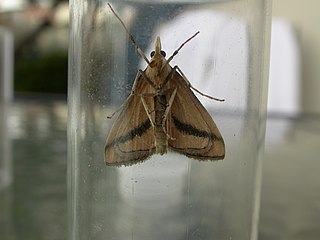
The Pyraloidea are a moth superfamily containing about 16,000 described species worldwide, and probably at least as many more remain to be described. They are generally fairly small moths, and as such, they have been traditionally associated with the paraphyletic Microlepidoptera.

Metasia liophaea is a species of moth of the family Crambidae. It is found in Australia, where it has been recorded from New South Wales and the Australian Capital Territory.
Glauconoe is a genus of moths of the family Crambidae. It contains only one species, Glauconoe deductalis, which is found in Australia (Queensland), New Guinea, Sri Lanka and Taiwan.

Tetridia is a monotypic moth genus of the family Crambidae described by William Warren in 1890. Its single species, Tetridia caletoralis, was described by Francis Walker in 1859. It is found in China, northern India, Sri Lanka, Myanmar, Malaysia, Papua New Guinea, Japan, Taiwan and Australia, where it has been recorded from Queensland.

Ephestiopsis oenobarella is a moth of the family Pyralidae. It is known from Australia. It is also present in New Zealand.

Osiriaca is a monotypic moth genus of the family Crambidae described by Francis Walker in 1866. Its only species, Osiriaca ptousalis, described by the same author in 1859, is known from Australia.

Hodebertia is a genus of micro-moth of the family Crambidae. It contains only one species, Hodebertia testalis, and is found in the tropics, but ranges north to parts of Europe on occasion.
Anassodes is a monotypic snout moth genus. It was described by Alfred Jefferis Turner in 1932, and contains the species Anassodes mesozonalis. It is found in Australia, including the type location of Western Australia.
Anemosa is a genus of snout moths. It was described by Francis Walker, in 1859, and is known from Australia.
Anemosa isadasalis is a species of snout moth in the genus Anemosa. It was described by Francis Walker, in 1859, and is known from Australia.
Cryptoblabes plagioleuca, the mango-flower moth, blossom moth or mango-flower webber, is a species of snout moth in the genus Cryptoblabes. It was described by Turner in 1904. It is found from Indonesia to Australia and the Society Islands.

The Phycitini are a tribe of moths of the family Pyralidae.

Diplopseustis perieresalis is a species of moth in the family Crambidae. It is widespread in the Oriental region, Australia and New Zealand, but was introduced to the Western Palaearctic ecozone, where it quickly expanded its range, and where it is now found in Great Britain, the Netherlands, Belgium, Germany, France, Switzerland, Spain, Portugal and the Canary Islands. In the Afrotropics, it has been recorded from Sudan.

Pyrausta phoenicealis, the perilla leaf moth, is a moth of the family Crambidae described by Jacob Hübner in 1818. It is found worldwide, including the Americas, Africa, Australia and Asia.
Hednota grammellus is a moth in the family Crambidae. It was described by Zeller in 1863. It is found in Australia, where it has been recorded from New South Wales and Victoria.
Hednota panteucha is a moth in the family Crambidae. It was described by Meyrick in 1885. It is found in Australia, where it has been recorded from South Australia and Victoria.

Camptomastix hisbonalis is a moth in the family Crambidae. It was described by Francis Walker in 1859. It is found on Borneo and in China, Taiwan, Papua New Guinea and Australia, where it has been recorded from New South Wales.
Eurybela trophoessa is a moth in the family Crambidae. It was described by Turner in 1908. It is found in Australia, where it has been recorded from Queensland and New South Wales.
Metallarcha diplochrysa, the golden metallarcha moth, is a moth in the family Crambidae. It was described by Edward Meyrick in 1884. It is found in Australia, where it has been recorded from South Australia.
Metallarcha leucodetis is a moth in the family Crambidae. It was described by Lower in 1899. It is found in Australia, where it has been recorded from New South Wales and South Australia.










